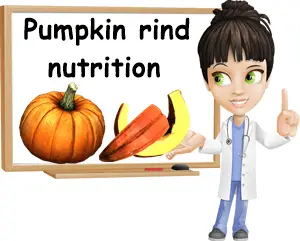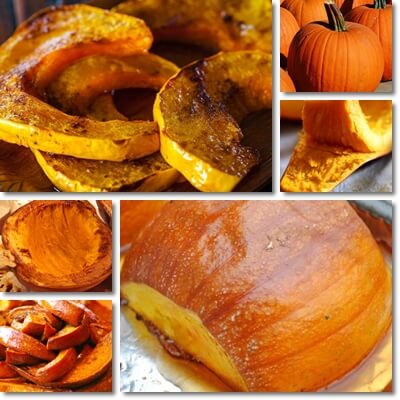Did you know that pumpkin is edible in its entirety? Pumpkin shoots, leaves, flowers, buds, pulp, seeds and rind are all perfectly edible, not to mention nutritious. Pumpkin rind in particular is an important source of pigmented antioxidants such as lutein, zeaxanthin and various carotenoids. Its nutrition expands to include pro-vitamin A carotenes such as alpha and beta-carotene for skin and eye health and excellent amounts of dietary fiber for digestive health. Pumpkin rind is also a modest source of several B vitamins and dietary minerals such as calcium, iron, magnesium, potassium and zinc.
What is pumpkin rind?
Pumpkin rind is the outer skin of pumpkin fruits. It’s thick and tough which is why it’s referred to as a ‘rind’. It can be peeled from the fruit which is why it’s also sometimes called a ‘pumpkin peel’. Only species of winter squash with a particular appearance, that is, deep yellow-orange rind and flesh, are considered true pumpkins, but any edible winter squash or gourd, pumpkin or not, also has perfectly edible skin.
The only difference is a variation in rind color will bring about variations in nutritional profile. An interesting fact: pumpkin rind is eaten as a vegetable, although pumpkins are culinary fruits and sometimes used as such (such as in pumpkin pie).

Can you eat pumpkin rind?
Yes, you can definitely eat pumpkin rind. Pumpkin rind is edible both raw and cooked. However, it typically requires cooking to soften it and make it more enjoyable to eat. The rind or peel of true pumpkins and other winter squashes, while perfectly edible both raw and cooked, is like a shell – thick and tough, and thus requires cooking. Vs that of summer squashes like zucchini or courgette, Korean zucchini, yellow squash, straightneck and crookneck squash, zucchetta and other summer squashes which is thin, tender and perfectly edible raw.
What does pumpkin rind look like?
Considering the only socially-acceptable definition of a pumpkin is that of a deep yellow to bright orange winter squash, preferably roundish and bulky-looking, with smooth and ribbed skin, it stands to reason that pumpkin rind can only be yellow-orange in color, smooth and ribbed. Also, because pumpkins are winter squash and allowed to mature completely before being picked, their rind is quite tough. Varieties that grow to more impressive sizes, such as the Atlantic Giant, may have a particularly tough skin which may prove more difficult to cook and eat.
What does pumpkin rind taste like?
The taste of pumpkin rind depends on the variety of pumpkin. Typically, sweeter pumpkins commonly used for making pumpkin pie and pastry filling have the best rind to eat: sweet and tender after cooking. Even so, you can eat pretty much any pumpkin rind. The secret is to know how to cook it so it becomes soft and tender. Oven-baking, roasting, boiling or steaming are great options.

Nutritional information of Pumpkin Rind
While it is difficult to quantify the vitamin, mineral and antioxidant content of pumpkin rind, some nutritional facts can be inferred from the nutrition of pumpkin flesh. For one, bright yellow and orange pumpkin rind is high in carotenoids such as xanthophylls (lutein, zeaxanthin) and carotenes (alpha-carotene and beta-carotene). Yellow pumpkin rind has more xanthophylls and less carotenes, vs orange pumpkin rind which has more of both. In other words, orange pumpkins and their rind are higher in carotenoid antioxidants than yellow ones. At the same time, pumpkins with green skin (e.g. Calabaza variety) are even higher in carotenes such as alpha and beta-carotene than orange cultivars.
Pumpkin rind is also high in vitamin A from antioxidant carotenes alpha and beta-carotene which exert effects identical to preformed vitamin A (retinol) once digested. That is, alpha and beta-carotene in pumpkin rind have vitamin A effects in the body. High in fiber, moreso than the flesh, the rind helps soften stools and restore bowel regularity, helping relieve constipation. Pumpkin rind is a source of B vitamins (B1, B2, B3, B6 and B9), choline, vitamins C and E, but has no vitamin D and no vitamin B12.
Green pumpkin rind contains vitamin K (e.g. Calabaza variety). Minerals in pumpkin rind include: calcium, copper, iron, magnesium, manganese, phosphorus, potassium, sodium and zinc. The rind is low-calorie, low-fat, cholesterol-free, low-protein and a modest source of carbohydrates. The exact nutritional values vary according to pumpkin variety, age and processing undergone (e.g. water soluble vitamins such as B vitamins and minerals leech into cooking water; heat destroys vitamin C). Also read the benefits of pumpkin flowers.
What are the benefits of Pumpkin Rind?
Although you can eat pumpkin rind separately from the flesh, nobody does so since it’s both easier and a more palatable experience to eat pumpkin with rind. This being said, here are some pumpkin peel benefits that can be associate with the exclusive consumption of the peel:
- Higher fiber intake. Edible peels are high in fiber in general, and pumpkin is too. Dietary fiber is an essential nutrient because of its varied positive effects on the human body, especially digestive health and bowel regularity.
- Constipation relief. Eating pumpkin rind ups fiber intake and helps soften stools and restore bowel regularity, helping relieve constipation.
- High in antioxidants. Lutein, zeaxanthin, alpha-carotene, beta-carotene and other polyphenols in pumpkin rind provide a host of benefits via their antioxidant action, helping reduce and repair cell damage caused by free radicals.
- Benefits for eyesight. Pumpkin rind is high in pro-vitamin A antioxidants alpha and beta-carotene, which get converted into vitamin A in the body, and lutein and zeaxanthin. The antioxidants contribute to the physical health of the eye as well as good visual acuity and color and low-light vision.
- Potential benefits for diabetes. Pumpkin in general has been found to have hypoglycemic effects (animal studies), in addition to containing elements that improve tolerance to glucose and increase insulin levels in blood serum for better glucose metabolism.
- Benefits for skin. The peel is high in carotenoid antioxidants that get turned into vitamin A following digestion and help with skin cell formation and differentiation and exert anti-aging properties. Pro tip: Eat your pumpkin with a source of fat (oil, butter, cream, mayonnaise) to better absorb the pro-vitamin A carotenoids for improved nutrition.
- Potential benefits for the immune system from pro-vitamin A antioxidants, zinc and vitamin C.
- Minor benefits for blood coagulation from vitamin K from pumpkin varieties with a deep green rind. Also see the benefits of pumpkin leaves.
What are the side effects of Pumpkin Rind?
- Loose stools and diarrhea. Eating a wedge of baked pumpkin can cause loose stools and diarrhea because of its fiber content. Eating it with rind can have the same effect, even more potent, because of the added fiber from the rind.
- Intestinal blockage. A rare side effect, it can be caused by eating raw pumpkin with rind in high amounts (the raw rind is thick and hard and can resist digestion) or swallowing pieces of raw pumpkin rind without chewing properly.
Pumpkin rind uses
There are many uses to pumpkin rind. Here are some things you can do with it:
- Eat it. It’ll likely taste better cooked, oven-baked or roasted, but also boiled or steamed, even fried. Cooking renders the tough rind soft and tender. Seasoning it adds to the flavor profile and you can make it taste sweet, spicy, savory or however you want.
- Dry or dehydrate and grind and use as supplement. You can then use the ground pumpkin rind as a nutritional supplement, to add more fiber to your diet or more antioxidants such as beta-carotene, lutein and zeaxanthin, all good for eye health. Just remember to store it in a clean recipient, in a dry and cool place.
- Incorporate it into your beauty routine. Keep the rind and grind it in a food processor, mix with honey or sugar and a few drops of olive oil or your favorite carrier oil and use on the face or body. Gently massaging the mixture into the skin produces a mild exfoliating effect that helps clean pores, unclogs dirt and other types of residue and reduce acne breakouts, thanks to the sugar crystals and pumpkin rind pieces. The honey exerts a local antibacterial action from the methylglyoxal in manuka honey or hydrogen peroxide in other types of honey. The pumpkin rind itself has pro-vitamin A antioxidant action and protects the skin in its entirety.
- Pickle it or turn it into jam. Cut pumpkin with rind into stripes or cubes and pickle with sugar, vinegar and oil. Or gently boil until soft with sugar (and also cinnamon, nutmeg and other spices) and turn into jam.
- Feed it to your chickens. Or other farm animals. Chickens will pick the rind clean and eat most of it too after that. Pigs will eat the entire pumpkin, rind and all. It’s a great source of nutrition for farm animals in general.
- Use it as a natural fertilizer. Throw the unused rinds in a bucket half-filled with dirt. Add other fruit and vegetable peels and mix everything regularly. Once everything’s reduced to dirt-like material, use it to feed your trees, flower beds or vegetable garden.
